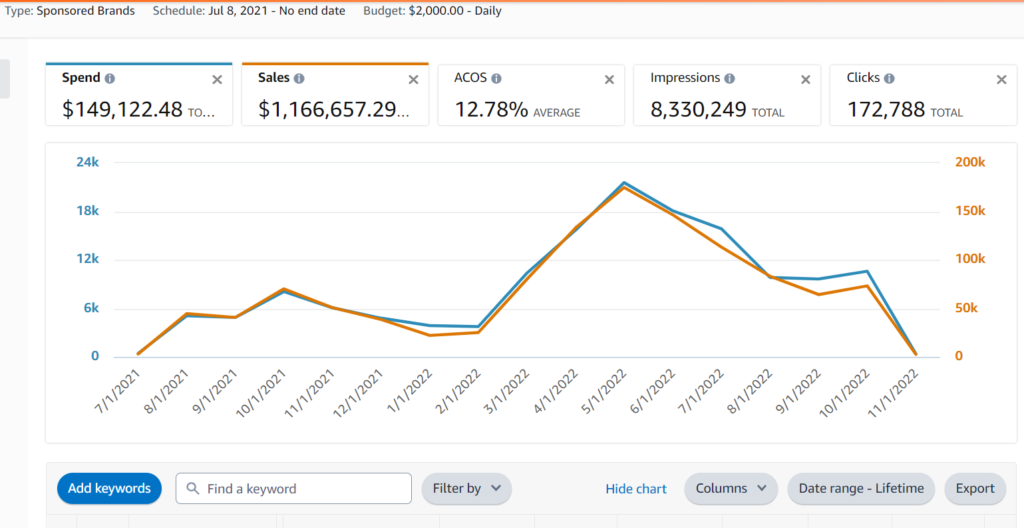
This is the unusual success story of a million dollar Amazon PPC campaign that targeted keywords that weren’t relevant to our product, according to Amazon’s algorithm.
Why Is Relevance Key In Traditional Sponsored Search Ads And Who Decides What’s Relevant?
Traditional search engine marketing (SEM) aka search engine advertising on Google or Bing requires you to be very relevant to the intent expressed by the search query. The reason for this is that search engines get paid when people click your ad. Irrelevant ads don’t get clicks, so search engines prioritize the ads that get clicked the most frequently.
How can you tell if your ad is relevant to the search query, before even launching your ad campaign?
The organic search algorithm generally does a good job returning relevant results for a search, so a look at what shows up in organic results can be a handy guide. That’s as true on Amazon as it is on Google.
The Challenge Our Client Faced In Advertising On These Keywords
Our client has a product that – semantically – can be a fit for a set of popular keywords on Amazon. However when you used to search organically – before we launched this campaign – no direct competitor showed up in Amazon’s search results. Nowadays, our client (and even some competitors) show up in those organic rankings.
For example, suppose we were selling plastic patio chairs. (I’m changing the example from what our client actually sells.) If the keyword was “patio furniture,” then plastic patio chairs are – theoretically – relevant.
What happens though when you search “patio furniture” and see that literally none of the search results feature plastic patio chairs?
It’s not that no one thought to sell them on Amazon. Obviously you could find plastic patio chairs on the site. Rather, Amazon’s not placing them in search results because people aren’t buying them after searching for patio furniture.
Continuing with the example, we saw wooden benches, glass and metal tables, sun-umbrellas etc. No plastic patio chairs.
If you saw search results like this, you wouldn’t advertise. Amazon’s search algorithm is designed to show what sells. If your product doesn’t show up, you can infer that it doesn’t convert on this keyword.
How To Make Your Amazon PPC Ads Relevant When The Algo Thinks You Aren’t
While we generally do follow the above rule of thumb, we saw that our keywords overlapped closely with the irrelevant set. It’s just that the irrelevant set of keywords were lacking a word that differentiates our products from those that were ranking. E.G. No mention of plastic in the keyword ‘patio furniture.’
We thought, what is it that people want when they buy these other products? We could brainstorm ideas, and read our competitors’ product listings. That wouldn’t tell us what the customers think though.
Ideally, we’d just let customers tell us. (Hat tip Josh Garofalo of Sway Copy , who shared the idea from Joanna Wiebe of Copy Hackers.)
We read the reviews on several products ranking at the top of organic results for ‘patio furniture’. We looked for patterns to see which benefits came up most frequently.
We saw two benefits that came up repeatedly. Benefits that our client’s product also provides.
We wrote up headlines for the ad that reflected the benefits. Lots of headlines.
Usually, your first draft of ad copy is not your best version so it’s best to take your time and write many headlines. For important keywords like these, we tend to write 10 or even 20 or 30 headlines.
Afterwards, we rate our headlines for clarity, specificity and avoidance of puns. For all the awards that funny ads get, 99% of the time funny ads don’t sell as well as plain ads. And the job of an ad is to sell, not entertain.
In general, it’s preferable to focus on a single benefit per headline as that allows you greater clarity. Here though, each benefit could be summarized in a single word, e.g. seating.
So our headline was roughly equivalent to “Plastic patio chairs give you seating for guests.” It’s the same benefit they wanted in searching for ‘patio furniture’ but we linked the benefit to our products.
Once we had our headline, we weren’t done creating the ad. We also needed to choose what products to feature in the ad and what pages to link to in our Amazon brand store.
For that, we followed the process outlined here in our $400K Store Spotlight PPC campaign case study.
To summarize, we linked to store pages that segmented visitors by their preference around the main feature that differentiates between products in the line. E.G. Black plastic chairs vs white plastic chairs vs blue.
When we launched, we had limited expectations. The keywords normally wouldn’t produce much given that the algorithm showed literally zero direct competitors (“substitutes” in Amazon advertising terminology) .
Yet the clickthrough rate and conversion rate proved themselves, and in fact this campaign made nearly $200K in season, and continues to produce nicely. To date it’s made over $1,1M, at a very solid 12.78% ACOS.
If you’re looking to increase your Amazon PPC sales perhaps you’d like to find a time for us to speak about your ads?
